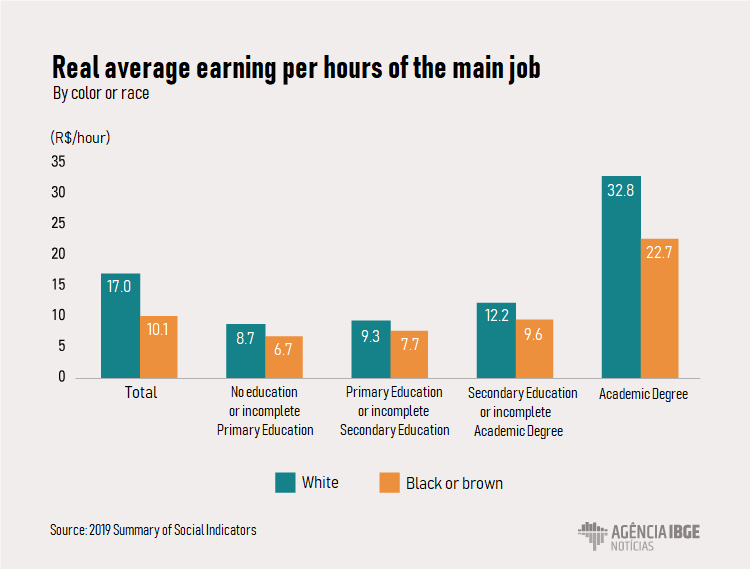Summary of Social Indicators
Blacks or browns represent two-thirds of the underemployed in 2018
November 06, 2019 10h00 AM | Last Updated: November 26, 2019 09h23 AM

The labor market is still very uneven for blacks or browns, women and youngsters. In 2018, blacks or browns were about two-thirds (66%) of the 6.9 million time-related underemployed, those who work less than 40 hours a week and would like to work more. Underemployment is also high among women: they were 43.7% of the employed population, but 54.6% of the underemployed. In turn, the group aged 14 to 29 was 25.7% of the employed, but 34.5% of the underemployed.
The 2019 Summary of Social Indicators, released today by the IBGE, shows that the difference between the unemployment rate for blacks or browns and for the white population achieved its highest level in 2018: 14.1% in the first group against 9.5% in the second. In the same year, there was a smooth reduction of the general unemployment rate in relation to 2017, from 12.5% to 12%.
“As the white population has the highest index of schooling, in any level of schooling, the unemployment rate is always higher for blacks and browns, but among people with a Bachelor or equivalent degree, this rate is essentially lower, thus, the access to education is a factor that reduces social inequality.”, comments Ms. Luanda Botelho, IBGE analyst of Summary of Social Indicators. Among people with a higher education, the unemployment rate was of 5.5% for white population and 7.1% for black and brown population in 2018.
White workers earn up to 73.9% more
In 2018, the white population earned, on average, 73.9% more than blacks and browns. And the social inequality has been the same even considering the wages per hours worked.
The hours paid to the white employed population (R$ 17) was 68.3% higher than that of the black or brown population (R$ 10.10). The biggest difference in the hours paid was among the workers with Bachelor or equivalent degree: R$32.8 for white people and R$22.7 for blacks and browns.

Blacks and browns are the majority in activities with lower earnings: Agriculture (60.8%), Construction (62.6%) and Domestic Services (65.1%). In turn, white people are the majority in groups with higher earnings, like Financial information, Economy and other professional activities and Public Administration, Education, Health and Social Services.
In 2018, the gap in the population average earnings achieved its highest level between the 10% of the population with the highest salary and the 40 % with the lowest: 13 times more, stimulated, mainly, by the lack of increase in the minimum wages.
The Federation Units with the greatest differences were Piauí (over 18 times), Paraíba and Sergipe (around 16 times) and the smallest ones were in Santa Catarina, Goiás, Alagoas and Mato Grosso (all of them under the 10 times).
Informality is also more common among blacks and browns with 47.3% working in this condition, against the 34.6% of whites. In this group are the persons in the private sector and domestic workers without formal contract; self-employed workers and workers who do not contribute to the social security system; and contributing family workers.
Brazil has one of the worst indexes of young people who do not study or work.
Around 2.4 million young people aged 15 to 29 in Brazil did not study or work in 2018, it Is equivalent to 23% of the population in this age group. At this level, Brazil becomes placed among the five worst positions among the 41 countries with membership or partnership in the Organization for Economic Cooperation and Development (OCDE).

The major occurrence of young people that did not study or work was in households with the lowest earnings: 42.3% of young people in the 1/5 of the population with the lowest per capita household earnings were in this condition. The lower the schooling, the higher the unemployment probability, and those who completed the Secondary Technical School had more opportunities in the labor market.
Women are the majority in this group. Although women have higher schooling, the proportion of young women (28.4%) who did not study or work was larger than that of men (17.6%). Black and brown women were the worst case, they had twice the chance of not getting education or or a jobas men.
More than a half (57.4%) of young people aged 15 to 29 not studying or working were discouraged. The major reasons are: the lack of opportunities in their region (39.6%); not getting the suitable job (10.7%); not having the needed profession experience or qualification (6.1%); or being too young to work (1%).




















